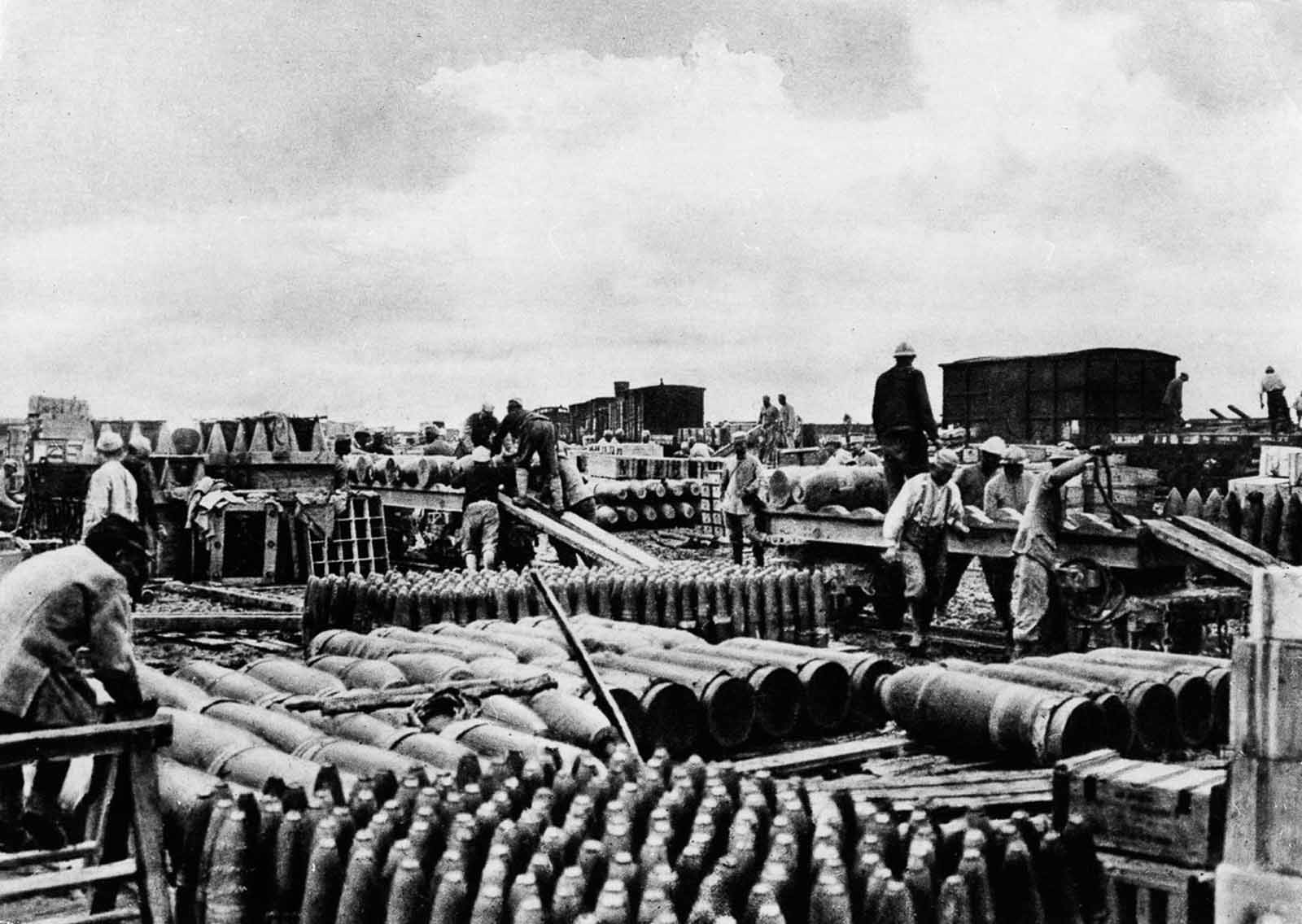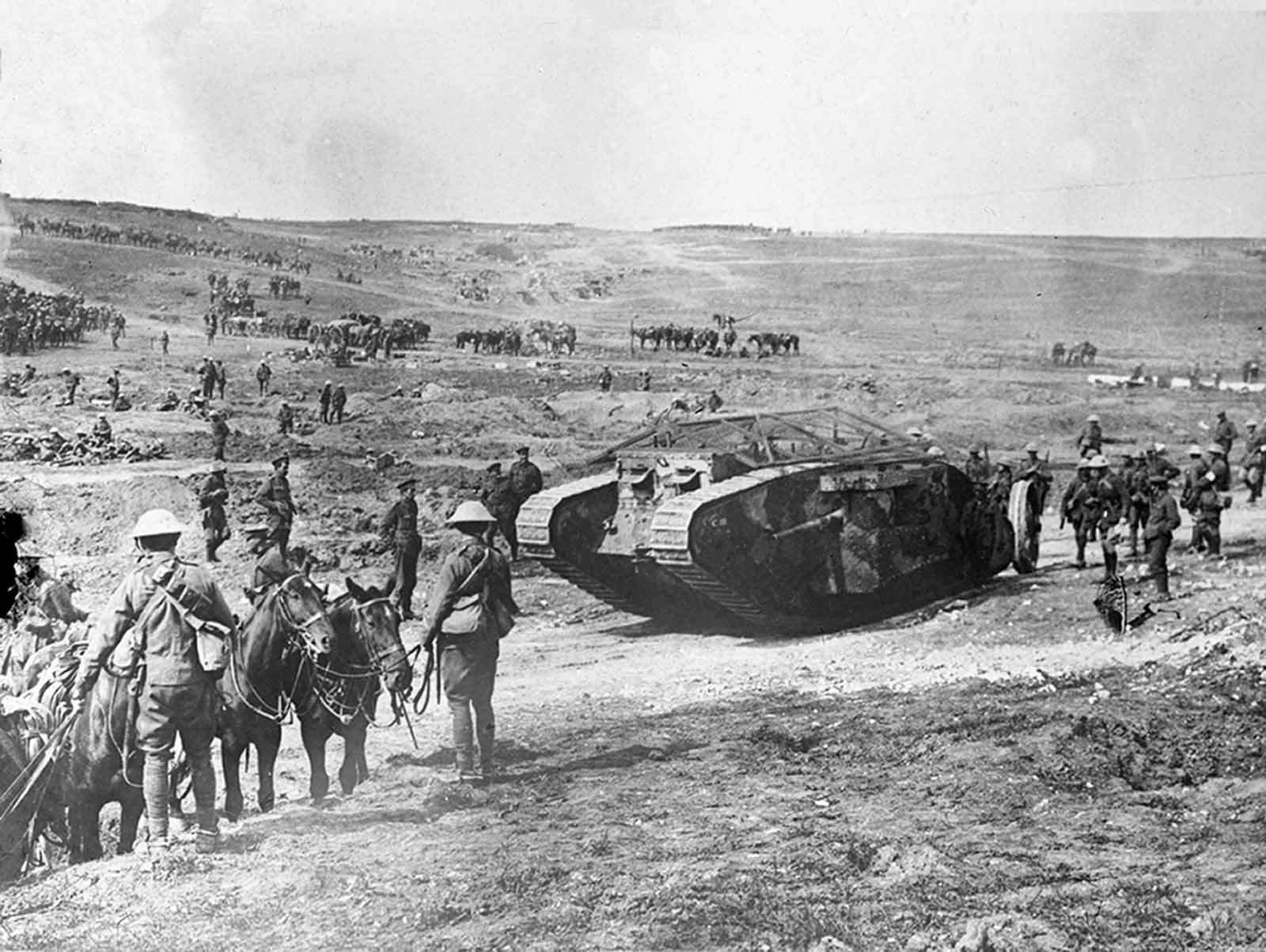In December 1915, Allied commanders had met to discuss strategies for the following year and agreed to launch a joint French and British attack in the region of the River Somme in the summer of 1916. The location was mainly chosen as it was where French and British forces on the Western Front met. But the German attack on the French at Verdun in February 1916 forced Britain to take the lead in the Somme offensive. A seven-day preliminary bombardment began on 24 June 1916 in an attempt to cut the barbed wire in front of the German lines and destroy trench defenses and artillery. In the week leading up to the battle, over 1.5 million shells were fired. The British believed that the Germans would be so shattered by this massive bombardment that British troops would be able to cross no man’s land and occupy the German trenches. Haig instructed General Rawlinson to prepare for ‘a rapid advance’. However, the British guns were too thinly spread to achieve this goal and around two-thirds of the shells were shrapnel, which were largely ineffective against the concrete dugouts. To make matters worse, it has been estimated that as many as 30% of the shells failed to explode. The British artillery was also unable to neutralize the German artillery, which would prove critical on the first day of the battle. On July 1, 1916, the first shots were fired in what would become one of the bloodiest engagements in human history, the 141-day Battle of the Somme. In most places, the artillery bombardment had failed to cut the German barbed wire or damage the defenders’ dugouts. Some senior commanders, not convinced that the inexperienced soldiers of New Armies (newly recruited) could cope with sophisticated tactics, ordered the infantry to advance in long, close-formed lines. German machine-gunners emerged from their intact shelters and mowed down the oncoming British infantry. The only substantial British success was in the south where using more imaginative tactics and helped by the French artillery on their immediate right, the 18th and 30th Divisions took all their objectives and the 7th Division captured Mametz. At Thiepval, the 36th (Ulster) Division seized the Schwaben Redoubt but was forced to withdraw because of lack of progress to its left and right. Elsewhere some British infantry made it into German positions but were forced to withdraw in the face of determined resistance and a huge volume of German artillery fire. These limited gains cost 57,470 British casualties – of which 19,240 were killed – making the first day of the Somme the bloodiest in British military history. The French Sixth Army had 1,590 casualties and the German 2nd Army had 10,000–12,000 losses. But there was no question of suspending the offensive with the French still heavily engaged at Verdun. The British did not achieve the quick breakthrough their military leadership had planned for and the Somme became a deadlocked battle of attrition. The lack of a decisive breakthrough on the opening day resulted in attritional or ‘wearing out’ fighting during the following two months. The remainder of the battle was characterized by relentless British attacks and equally determined German counterattacks. By mid-September, the British were ready to assault the German third line of defenses with a new weapon, the tank. Objectives for 15 September included the Fourth Army’s capture of the German defenses at Flers and the seizure of Gueudecourt, Lesboeufs and Morval. The Canadian Corps of Gough’s Reserve Army was to take Courcelette. Of 49 tanks available to support the infantry, only 36 reached their starting points, though these caused alarm among the German defenders. Flers and Courcelette fell but the advance on 15 September was limited to about 2,500 yards (2,286m) on a three-mile (4.8km) front. The Germans retained Morval and Lesboeufs for a further ten days and the offensive stalled. The last act of the Somme offensive took place in the Ancre sector from 13 to 19 November. The operation went ahead, despite repeated postponements, largely because it was hoped that a late British success might create a favorable impression at the inter-Allied conference at Chantilly on 15 November. Although the Germans were weakened, the Allies failed to achieve all of their objectives and the war was to continue for another two years. British survivors of the battle had gained experience and the BEF learned how to conduct the mass industrial warfare, which the continental armies had been fighting since 1914. The continental powers had begun the war with trained armies of regulars and reservists, which were wasting assets. Crown Prince Rupprecht of Bavaria wrote, “What remained of the old first-class peace-trained German infantry had been expended on the battlefield”. A war of attrition was a logical strategy for Britain against Germany, which was also at war with France and Russia. A school of thought holds that the Battle of the Somme placed unprecedented strain on the German army and that after the battle it was unable to replace casualties like-for-like, which reduced it to a militia. The British and French had advanced about 6 mi (9.7 km) on the Somme, on a front of 16 mi (26 km) at a cost of 419,654 to 432,000 British and about 200,000 French casualties, against 465,181 to 500,000 or perhaps even 600,000 German casualties. Until the 1930s the dominant view of the battle in English-language writing was that the battle was a hard-fought victory against a brave, experienced, and well-led opponent. Winston Churchill had objected to the way the battle was being fought in August 1916, Lloyd George when Prime Minister criticized attrition warfare frequently and condemned the battle in his post-war memoirs. In the 1930s a new orthodoxy of “mud, blood and futility” emerged and gained more emphasis in the 1960s when the 50th anniversaries of the Great War battles were commemorated. The Battle of the Somme was one of the costliest battles of World War I. The original Allied estimate of casualties on the Somme, made at the Chantilly Conference on 15 November 1916, was 485,000 British and French casualties and 630,000 German. Friedrich Steinbrecher, a German officer wrote: “Somme. The whole history of the world cannot contain a more ghastly word”. The Somme is commonly thought of as a ground offensive – but it was conducted from the air too. The Royal Flying Corps, the air army of the British Army, lost 800 aircraft and 252 aircrew were killed. Anne Frank’s father Otto, Hitler, Wilfred Owen and JRR Tolkien all took part in the Battle of the Somme. It was in this war that Hitler sustained his leg injury, and the rumored injury to his groin. (Photo credit: National Archives of France / Bundesarchiv / IWM / Library of Congress). Notify me of new posts by email.
Δ Subscribe




































